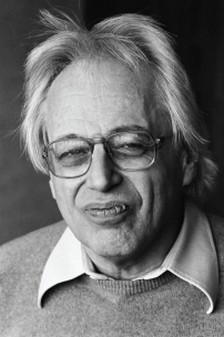
György Ligeti (1923–2006, Hungary) graduated in 1949 at the Academy of Music in Budapest and returned there the following year to teach harmony and counterpoint. In December 1956, two months after the Hungarian Revolution, Ligeti fled to Vienna and from there on to Cologne. There he met several key avant-garde figures (Karlheinz Stockhausen, Gottfried Michael Koenig) and learned many contemporary musical styles and methods. In 1958 he taught for the first time at Darmstadt, where he regularly returned during the next decade. During that period, he composed Apparitions for orchestra (1958–59), where he – simultaneously with, but independently of Xenakis, Penderecki and Stockhausen – introduced orchestral clusters and his unique technique of micro-polyphony (in the second movement). The first performance of Apparitions, in 1960, laid the foundation of his international reputation and was followed by his best-known works: Atmosphères (1961), Volumina(1962–66), Aventures, Nouvelles aventures (1962–65), Lux aeterna (1966), and Lontano (1967). In 1969–70 a Deutsche akademischer Austauschdienst scholarship took him to Berlin; in 1972 he was a visiting professor at Stanford University; and in 1973 he accepted a permanent position at the Musikhochschule in Hamburg, where he moved permanently. For the Swedish Royal Opera he composed his only operatic piece, Le Grand Macabre (1974-77). Following its première in Stockholm, Le Grand Macabre enjoyed an extraordinary number of productions for a modern opera, including in Hamburg, Saarbrücken, Bologna, Nuremberg, Paris, and London. In his music of the 1980s and 1990s, Ligeti continued to emphasise complex mechanical rhythms (as in Atmosphères and Lontano), often in a less dense chromatic idiom, tending to favour displaced major and minor triads and poly-modal structures. In that period he completed three books of Étudesfor piano, as well as his PianoandViolin Concerto.
Volumina (1962/1966). No other 20th-century organ composition stirred such uproar as Volumina. A graphic score with verbal directions and no notes, featuring completely new playing techniques demanding the use of palms and elbows (seldom fingers) to perform moving clusters, entails turning the motor on and off during playing, strives for an avant-garde sound picture inspired by electronic music, using ‘impossible’ stop combinations and requiring multiple assistants in active roles – all of these radically new concepts, which seemingly appeared out of nowhere, flabbergasted the then conservative organ community. The first recording attempt accidentally ended with the organ catching fire, earning Ligeti the (undeserved) reputation of ‘the destroyer of organs’; the church authorities in Bremen banned the première concert (though on account of another composition, by Hans Otte, featuring a dancer in front of the altar). In summary, Volumina acquired a status somewhat similar to The Rite of Spring, a scandal that ushered in a new era. Its radical techniques soon became mainstream (all too frequently imitated) procedures; however, Volumina still deservedly carries the designation of an ‘avant-garde classic’. [Tonight’s performance is, most probably, the first in Serbia!]


